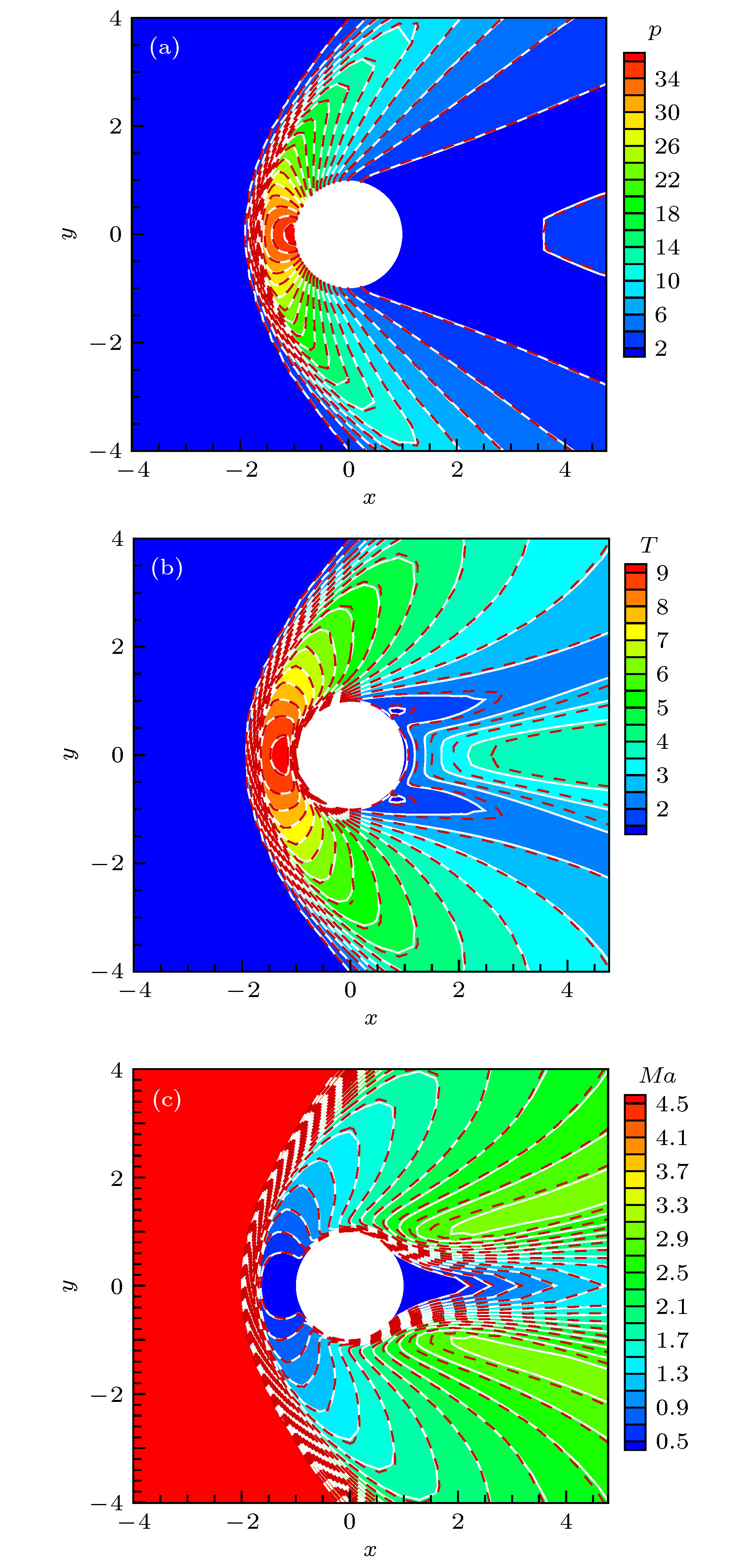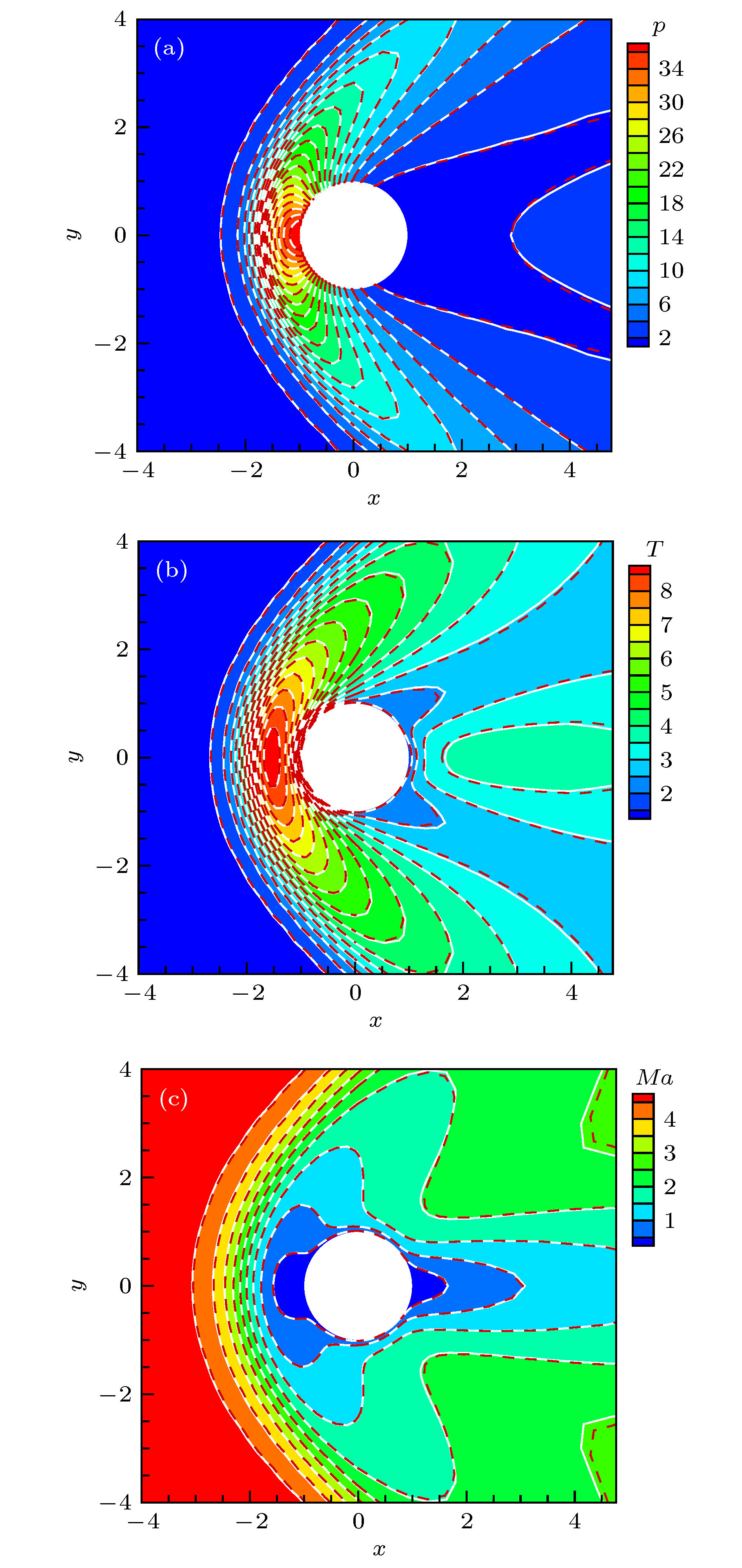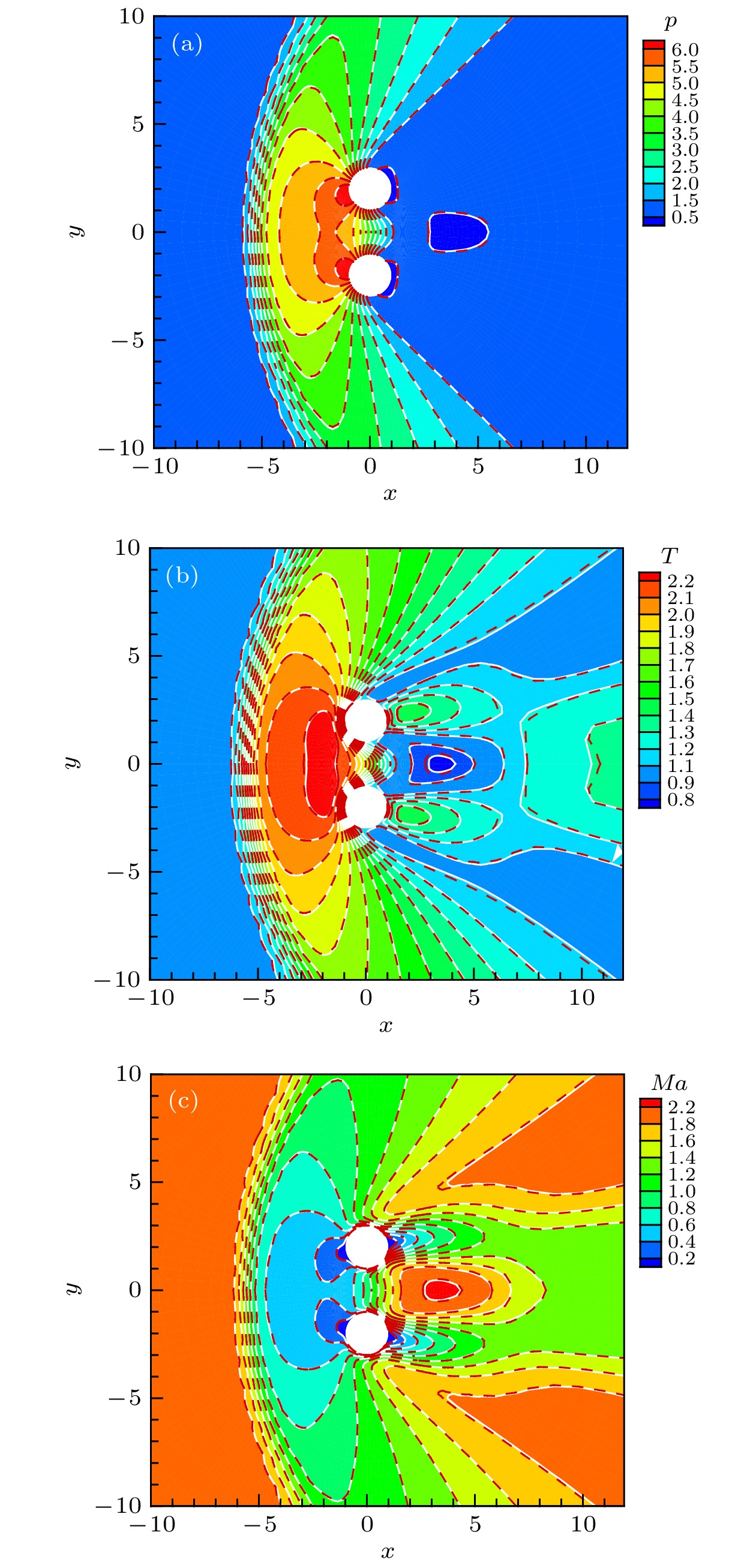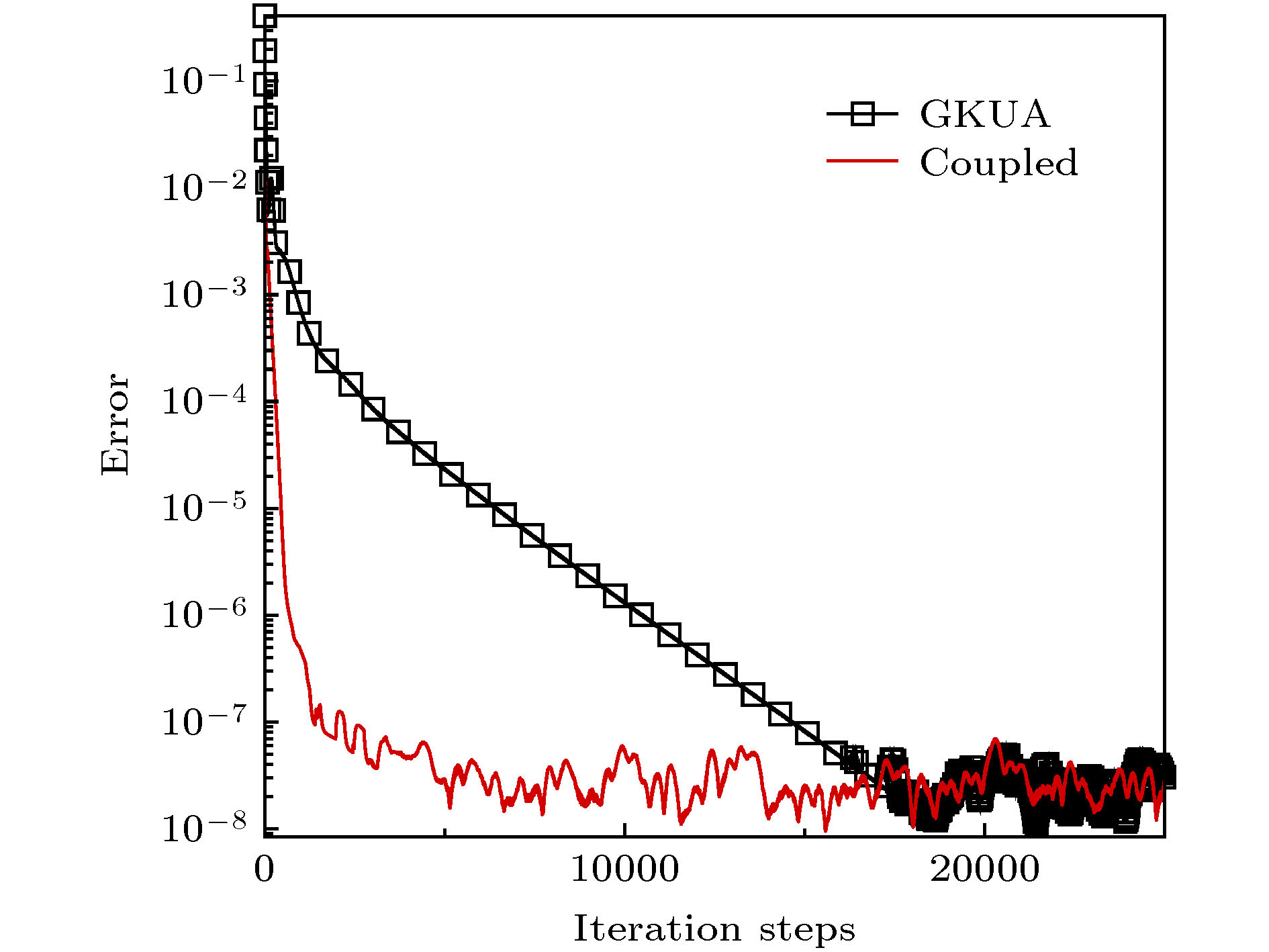-
In the simulation of complex multi-scale flows covering various flow regimes, the computational efficiency of gas kinetic method by which the evolution equation of velocity distribution function is solved directly is the key to engineering applications. In order to accelerate simulation for steady flows, a gas kinetic algorithm accelerated by utilizing the macroscopic conservative equations with a digital constitutive relation is developed. In this algorithm, the contribution of the high-order terms of stress and heat flux in macroscopic conservative equations is determined by the gas kinetic solution. Meanwhile, the solution of the macroscopic conservative equations provides the macroscopic quantities for the equilibrium distribution function in the Boltzmann model equation, where a fully implicit scheme to solve the Boltzmann model equation is developed. Extensive validations are performed for the cavity flow, the supersonic flow around the cylinder, and the interactive rarefied flow around two side-by-side cylinders. The results from the above method are in good agreement with the results from the conventional gas kinetic unified algorithm and the direct simulation Monte Carlo method. It can be concluded that the nonlinear constitutive relation of rarefied flow can be well captured by the present method. And the ability of this method to simulate complex flows such as shock wave, strong wall shear and flow separation is demonstrated. Furthermore, the present method has shown to be much faster than the conventional gas kinetic unified algorithm, especially for the low-Kn flows. As the value of Kn increases, the acceleration rate decreases, because the effect of flow convection becomes weak. Meanwhile, more effort is needed to reduce inner loop iterations to improve its efficiency. -
Keywords:
- gas kinetic unified algorithm /
- constitutive relation /
- convergence accelerated method /
- coupled method
[1] Cercignani C 1988 The Boltzmann Equation and its Applications (New York: Springer) pp40−103
[2] Kremer G M 2010 An Introduction to the Boltzmann Equation and Transport Processes in Gases (Berlin: Springer) pp37−80
[3] Shakhov E M 1968 Fluid Dyn. 3 95
[4] Brull S, Schneider J 2009 Cont. Mech. Thermodyn. 20 489
 Google Scholar
Google Scholar
[5] Broadwell J 1964 J. Fluid Mech. 19 401
 Google Scholar
Google Scholar
[6] Huang A B, Huang P F, Giddens D P, Srinivasan R 1973 Phys. Fluids 16 814
 Google Scholar
Google Scholar
[7] 李志辉 2001 博士学位论文 (绵阳: 中国空气动力研究与发展中心)
Li Z H 2001 Ph. D. Dissertation (Mianyang: China Aerodynamics Research and Development Center) (in Chinese)
[8] Li Z H, Zhang H X 2004 J. Comput. Phys. 223 708
[9] Li Z H, Zhang H X 2008 Int. J. Comput. Fluid Dyn. 22 623
 Google Scholar
Google Scholar
[10] Li Z H, Zhang H X 2009 J. Comput. Phys. 228 1116
 Google Scholar
Google Scholar
[11] Xu K, Huang J C 2010 J. Comput. Phys. 229 7747
 Google Scholar
Google Scholar
[12] Jin S, Wang L 2013 SIAM J. Sci. Comput. 35 799
 Google Scholar
Google Scholar
[13] Jin S 1999 SIAM J. Sci. Comput. 21 441
 Google Scholar
Google Scholar
[14] Gu X J, Emerson D R 2011 Microfluid. Nanofluid. 10 389
 Google Scholar
Google Scholar
[15] 许爱国, 张广财, 李英骏, 李华 2014 物理学进展 34 136
 Google Scholar
Google Scholar
Xu A G, Zhang G C, Li Y J, Li H 2014 Prog. Phys. 34 136
 Google Scholar
Google Scholar
[16] 许爱国, 张广财, 应阳君 2015 64 184701
 Google Scholar
Google Scholar
Xu A G, Zhang G C, Ying Y J 2015 Acta Phys. Sin. 64 184701
 Google Scholar
Google Scholar
[17] Li Z H, Peng A P, Zhang H X, Yang J Y 2015 Prog. Aerosp. Sci. 74 81
 Google Scholar
Google Scholar
[18] Li Z H, Peng A P, Ma Q, Dang L N, Tang X W, Sun X Z 2019 Adv. Aerodyn. 1 1
 Google Scholar
Google Scholar
[19] 彭傲平 2017 博士学位论文 (绵阳: 中国空气动力研究与发展中心)
Peng A P 2017 Ph. D. Dissertation (Mianyang: China Aerodynamics Research and Development Center) (in Chinese)
[20] 李志辉, 梁杰, 李中华, 李海燕, 吴俊林, 戴金雯, 唐志共 2018 空气动力学学报 36 826
 Google Scholar
Google Scholar
Li Z H, Liang J, Li Z H, Li H Y, Wu J L, Dai J W, Tang Z G 2018 Acta Aerodynam. Sin. 36 826
 Google Scholar
Google Scholar
[21] 吴俊林 2018博士学位论文 (绵阳: 中国空气动力研究与发展中心)
Wu J L 2018 Ph. D. Dissertation (Mianyang: China Aerodynamics Research and Development Center) (in Chinese)
[22] Mieussens L 2000 J. Comput. Phys. 162 429
 Google Scholar
Google Scholar
[23] Chen S Z, Xu K, Lee C B, Cai Q D 2012 J. Comput. Phys. 231 6643
 Google Scholar
Google Scholar
[24] 江定武 2016 博士学位论文 (绵阳: 中国空气动力研究与发展中心)
Jiang D W 2016 Ph. D. Dissertation (Mianyang: China Aerodynamics Research and Development Center) (in Chinese)
[25] Li Z H, Bi L, Tang Z G 2009 Appl. Math. Mech.-Engl. 30 889
 Google Scholar
Google Scholar
[26] Peng A P, Li Z H, Wu J L, Jiang X Y 2016 J. Comput. Phys. 327 919
 Google Scholar
Google Scholar
[27] Hu W Q, Li Z H 2018 Comput. Math. Appl. 75 4179
 Google Scholar
Google Scholar
[28] Rovenskaya O, Croce G 2014 Vacuum 109 266
 Google Scholar
Google Scholar
[29] Valougeorgis D, Naris S 2003 SIAM J. Sci. Comput. 25 534
 Google Scholar
Google Scholar
[30] Zhu Y J, Zhong C W, Xu K 2017 Phys. Fluids 29 096102
 Google Scholar
Google Scholar
[31] Zhu Y J, Zhong C W, Xu K 2016 J. Comput. Phys. 315 16
 Google Scholar
Google Scholar
[32] Jin S, Slemrod M 2001 J. Stat. Phys. 103 1009
 Google Scholar
Google Scholar
[33] Struchtrup H, Torrilbon M 2003 Phys. Fluids 15 2668
 Google Scholar
Google Scholar
[34] Xiao H, Tang K 2017 Sci. Rep. 7 13108
 Google Scholar
Google Scholar
[35] Myong R S 2001 J. Comput. Phys. 168 47
 Google Scholar
Google Scholar
[36] 陈伟芳, 赵文文 2017 稀薄气体动力学矩方法及数值模拟 (北京: 科学出版社) 第1—16页
Chen W F, Zhao W W 2017 Moment Method and Numerical Simulation on Rarefied Gas Dynamics (Beijing: Science Press) pp1–16 (in Chinese)
[37] Su W, Zhu L H, Wang P, Zhang Y H, Wu L 2020 J. Comput. Phys. 407 109245
 Google Scholar
Google Scholar
[38] Adams M L, Larsen E W 2002 Prog. Nucl. Energy 40 3
 Google Scholar
Google Scholar
[39] Zhu L H, Pi X C, Su W, Li Z H, Zhang Y H, Wu L 2020 arXiv: 2004.10530 v [physics. comp-ph]
[40] Guo Z L, Xu K, Wang R J 2013 Phys. Rev. E 88 033305
 Google Scholar
Google Scholar
[41] Guo Z L, Wang R J, Xu K 2015 Phys. Rev. E 91 033313
 Google Scholar
Google Scholar
[42] Li X L http://pan.baidu.com/s/1 slfC5 Yl [2020-6-6]
[43] Kudryavtsev A N, Shershnev A A 2013 J. Sci. Comput. 57 42
 Google Scholar
Google Scholar
[44] 沈青 2003 稀薄气体动力学 (北京: 国防工业出版社) 第105−110页
Shen Q 2003 Rarefied Gas Dynamics (Beijing: National Defense Industry Press) pp105−110 (in Chinese)
[45] Yang L M, Chen Z, Shu C, Yang W M, Wu J, Zhang L Q 2018 Phys. Rev. E 98 063313
 Google Scholar
Google Scholar
[46] Bird G A 2005 Proceedings of the 24th International Symposium on Rarefied Gas Dynamics Bari, Italy, July 10−16, 2004 p541
[47] Zhu L H, Guo Z L, Xu K 2016 Comput. Fluids 127 211
 Google Scholar
Google Scholar
-
表 1 耦合加速收敛方法与常规GKUA的收敛情况对比
Table 1. Convergence comparison between the conventional GKUA and the coupled acceleration method.
Kn 迭代步数(收敛标准: 10–7) 加速比 GKUA Coupled 0.010 8000 170 47.00 0.075 2300 300 7.60 1.000 1200 1100 1.09 -
[1] Cercignani C 1988 The Boltzmann Equation and its Applications (New York: Springer) pp40−103
[2] Kremer G M 2010 An Introduction to the Boltzmann Equation and Transport Processes in Gases (Berlin: Springer) pp37−80
[3] Shakhov E M 1968 Fluid Dyn. 3 95
[4] Brull S, Schneider J 2009 Cont. Mech. Thermodyn. 20 489
 Google Scholar
Google Scholar
[5] Broadwell J 1964 J. Fluid Mech. 19 401
 Google Scholar
Google Scholar
[6] Huang A B, Huang P F, Giddens D P, Srinivasan R 1973 Phys. Fluids 16 814
 Google Scholar
Google Scholar
[7] 李志辉 2001 博士学位论文 (绵阳: 中国空气动力研究与发展中心)
Li Z H 2001 Ph. D. Dissertation (Mianyang: China Aerodynamics Research and Development Center) (in Chinese)
[8] Li Z H, Zhang H X 2004 J. Comput. Phys. 223 708
[9] Li Z H, Zhang H X 2008 Int. J. Comput. Fluid Dyn. 22 623
 Google Scholar
Google Scholar
[10] Li Z H, Zhang H X 2009 J. Comput. Phys. 228 1116
 Google Scholar
Google Scholar
[11] Xu K, Huang J C 2010 J. Comput. Phys. 229 7747
 Google Scholar
Google Scholar
[12] Jin S, Wang L 2013 SIAM J. Sci. Comput. 35 799
 Google Scholar
Google Scholar
[13] Jin S 1999 SIAM J. Sci. Comput. 21 441
 Google Scholar
Google Scholar
[14] Gu X J, Emerson D R 2011 Microfluid. Nanofluid. 10 389
 Google Scholar
Google Scholar
[15] 许爱国, 张广财, 李英骏, 李华 2014 物理学进展 34 136
 Google Scholar
Google Scholar
Xu A G, Zhang G C, Li Y J, Li H 2014 Prog. Phys. 34 136
 Google Scholar
Google Scholar
[16] 许爱国, 张广财, 应阳君 2015 64 184701
 Google Scholar
Google Scholar
Xu A G, Zhang G C, Ying Y J 2015 Acta Phys. Sin. 64 184701
 Google Scholar
Google Scholar
[17] Li Z H, Peng A P, Zhang H X, Yang J Y 2015 Prog. Aerosp. Sci. 74 81
 Google Scholar
Google Scholar
[18] Li Z H, Peng A P, Ma Q, Dang L N, Tang X W, Sun X Z 2019 Adv. Aerodyn. 1 1
 Google Scholar
Google Scholar
[19] 彭傲平 2017 博士学位论文 (绵阳: 中国空气动力研究与发展中心)
Peng A P 2017 Ph. D. Dissertation (Mianyang: China Aerodynamics Research and Development Center) (in Chinese)
[20] 李志辉, 梁杰, 李中华, 李海燕, 吴俊林, 戴金雯, 唐志共 2018 空气动力学学报 36 826
 Google Scholar
Google Scholar
Li Z H, Liang J, Li Z H, Li H Y, Wu J L, Dai J W, Tang Z G 2018 Acta Aerodynam. Sin. 36 826
 Google Scholar
Google Scholar
[21] 吴俊林 2018博士学位论文 (绵阳: 中国空气动力研究与发展中心)
Wu J L 2018 Ph. D. Dissertation (Mianyang: China Aerodynamics Research and Development Center) (in Chinese)
[22] Mieussens L 2000 J. Comput. Phys. 162 429
 Google Scholar
Google Scholar
[23] Chen S Z, Xu K, Lee C B, Cai Q D 2012 J. Comput. Phys. 231 6643
 Google Scholar
Google Scholar
[24] 江定武 2016 博士学位论文 (绵阳: 中国空气动力研究与发展中心)
Jiang D W 2016 Ph. D. Dissertation (Mianyang: China Aerodynamics Research and Development Center) (in Chinese)
[25] Li Z H, Bi L, Tang Z G 2009 Appl. Math. Mech.-Engl. 30 889
 Google Scholar
Google Scholar
[26] Peng A P, Li Z H, Wu J L, Jiang X Y 2016 J. Comput. Phys. 327 919
 Google Scholar
Google Scholar
[27] Hu W Q, Li Z H 2018 Comput. Math. Appl. 75 4179
 Google Scholar
Google Scholar
[28] Rovenskaya O, Croce G 2014 Vacuum 109 266
 Google Scholar
Google Scholar
[29] Valougeorgis D, Naris S 2003 SIAM J. Sci. Comput. 25 534
 Google Scholar
Google Scholar
[30] Zhu Y J, Zhong C W, Xu K 2017 Phys. Fluids 29 096102
 Google Scholar
Google Scholar
[31] Zhu Y J, Zhong C W, Xu K 2016 J. Comput. Phys. 315 16
 Google Scholar
Google Scholar
[32] Jin S, Slemrod M 2001 J. Stat. Phys. 103 1009
 Google Scholar
Google Scholar
[33] Struchtrup H, Torrilbon M 2003 Phys. Fluids 15 2668
 Google Scholar
Google Scholar
[34] Xiao H, Tang K 2017 Sci. Rep. 7 13108
 Google Scholar
Google Scholar
[35] Myong R S 2001 J. Comput. Phys. 168 47
 Google Scholar
Google Scholar
[36] 陈伟芳, 赵文文 2017 稀薄气体动力学矩方法及数值模拟 (北京: 科学出版社) 第1—16页
Chen W F, Zhao W W 2017 Moment Method and Numerical Simulation on Rarefied Gas Dynamics (Beijing: Science Press) pp1–16 (in Chinese)
[37] Su W, Zhu L H, Wang P, Zhang Y H, Wu L 2020 J. Comput. Phys. 407 109245
 Google Scholar
Google Scholar
[38] Adams M L, Larsen E W 2002 Prog. Nucl. Energy 40 3
 Google Scholar
Google Scholar
[39] Zhu L H, Pi X C, Su W, Li Z H, Zhang Y H, Wu L 2020 arXiv: 2004.10530 v [physics. comp-ph]
[40] Guo Z L, Xu K, Wang R J 2013 Phys. Rev. E 88 033305
 Google Scholar
Google Scholar
[41] Guo Z L, Wang R J, Xu K 2015 Phys. Rev. E 91 033313
 Google Scholar
Google Scholar
[42] Li X L http://pan.baidu.com/s/1 slfC5 Yl [2020-6-6]
[43] Kudryavtsev A N, Shershnev A A 2013 J. Sci. Comput. 57 42
 Google Scholar
Google Scholar
[44] 沈青 2003 稀薄气体动力学 (北京: 国防工业出版社) 第105−110页
Shen Q 2003 Rarefied Gas Dynamics (Beijing: National Defense Industry Press) pp105−110 (in Chinese)
[45] Yang L M, Chen Z, Shu C, Yang W M, Wu J, Zhang L Q 2018 Phys. Rev. E 98 063313
 Google Scholar
Google Scholar
[46] Bird G A 2005 Proceedings of the 24th International Symposium on Rarefied Gas Dynamics Bari, Italy, July 10−16, 2004 p541
[47] Zhu L H, Guo Z L, Xu K 2016 Comput. Fluids 127 211
 Google Scholar
Google Scholar
Catalog
Metrics
- Abstract views: 7132
- PDF Downloads: 82
- Cited By: 0














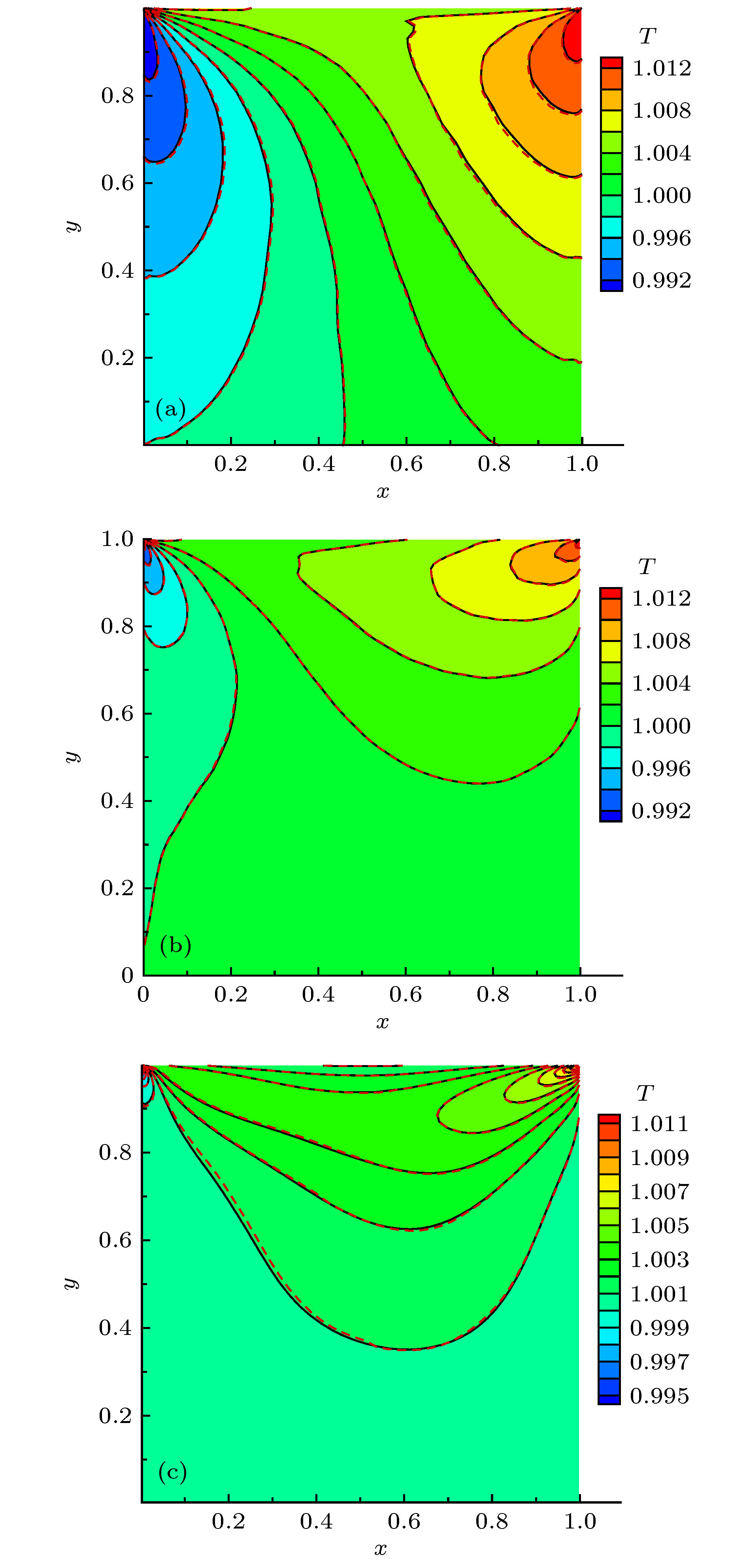
 DownLoad:
DownLoad:


